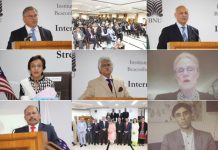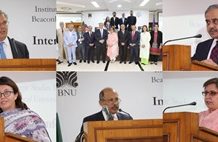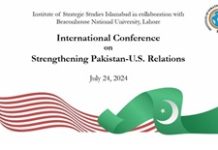Kashmir has been simmering in decades of conflict since the partition of the Indian subcontinent in 1947. The violence reached its peak in the 1980s and ‘90s, when the Pakistan-backed Kashmiri insurgency was at its strongest. By the early 2000s, however, the violence seemed to have abated, and there was hope for a peaceful settlement of the issue. But now, optimism for such a peaceful settlement is dwindling. As Kashmir has seen a resurgence in violence, public support for the insurgency also seems to be increasing. India is losing whatever support it had among the general Kashmiri public, and this trend will continue unless it brings about a radical change in its Kashmir policy. Following the 1947 partition, the political status of the formerly independent princely state of Kashmir was left largely contested by both Pakistan and India, which led to the establishment of the Line of Control (LoC), dividing Kashmir between India and Pakistan after a U.N.-backed ceasefire. However, there were aspirations for political independence among some Kashmiris. By the late 1980s, such aspirations had taken the shape of an armed revolt, backed by Pakistan, against Indian rule in Kashmir. India responded with a massive crackdown on the militants, deploying over half a million soldiers in Kashmir, often leading to grave human rights violations. Top News from Foreign Policy 5/11/2016 India is Losing Kashmir | Foreign Policy http://foreignpolicy.com/2016/05/05/indiaislosingkashmir/ 2/7 Promoted By The violence of the late 1980s and 1990s, which claimed thousands of lives, began to recede at the beginning of the new millennium, as people gained faith in the dialogue process. In the following decade, militancy-related causalities decreased significantly from 4,507 in 2001 to 377 in 2009. A major factor that contributed to the decline in the violence was the endorsement of the dialogue process by India’s thenPrime Minister Atal Bihari Vajpayee, which led to the historic Lahore Declaration in 1999, in which both India and Pakistan committed to the peaceful resolution of the Kashmir issue. The repeated efforts of the Vajpayee government to bring the pro-separatist Hurriyat political party and even the Hizbul Mijahideen militant group to the table for talks led to a ceasefire. The option of autonomy within the ambit of the Indian constitution offered by Vajpayee further fed the optimism for a peaceful settlement with India. This political shift resulted in a relative calm over the ensuing years, with tourism and business in Kashmir flourishing. 5/11/2016 India is Losing Kashmir | Foreign Policy http://foreignpolicy.com/2016/05/05/indiaislosingkashmir/ 3/7 However, a civilian uprising in 2010 and India’s brutal response signaled a shift in the political climate. In the subsequent years, there has been a new surge in Kashmiri youth taking up arms against the Indian establishment. Most of these young people are educated and come from well-off families in Kashmir. These youths – who are mostly joining Hizbul Mujahideen – are garnering huge support from the general population, and are increasingly attracting more and more peers to join their ranks. The face of this new insurgency has been Burhan Muzaffar Wani, a young, social media-savvy militant who openly poses for pictures with automatic assault rifles in hand and shares them on Facebook, drawing a huge number of sympathetic comments. He has since released audio and video messages inviting other young Kashmiris to join the insurgency and fight the Indian establishment. During a 2011 gunfight in Pulwama in southern Kashmir, locals threw stones and bricks at Indian soldiers in a bid to help a trapped militant escape the cordon. This has become commonplace to the point where security forces have sought to implement Section 144 of India’s criminal procedure code, which prohibits the gathering of people around an “encounter site” within a radius of 1.2 miles. On Feb. 21, local civilians were seen defying these restrictions when they marched towards such an encounter site in the southern town of Pampore, again hurling stones at the security personnel. 5/11/2016 India is Losing Kashmir | Foreign Policy http://foreignpolicy.com/2016/05/05/indiaislosingkashmir/ 4/7 In October of last year, Abu Qasim, a top commander of the militant group Lashkar-e-Taiba – believed to be responsible for several attacks on the Indian Army including the 2013 Hyderpora ambush – was killed. A sea of people attended his funeral procession. Authorities confirmed that militants also attended the funeral and fired a three-volley salute to honor his death. As if this were not enough, people from the villages of Khandaypora and Bugam clashed with each other over “the honor” of burying his body in their respective villages. Then, in November, an armed conflict between militants and the Indian Army broke out in the Manigah forests of Kupwara in Indian-administered Kashmir, lasting 27 days, killing two Indian soldiers, and leaving six others injured. The General Officer Commanding (GoC) of the Indian Army’s Srinagar-based 15 Corps stated that the militants were getting supplies from the locals in the area. In yet another incident, nearly 25,000 people attended the funeral procession of Shariq Ahmad Bhat, a member of the Hizbul Mujahideen militant group, who was killed in Pulwama district on Jan. 20 of this year. Militants were seen firing their AK-47 rifles in salute. The growing participation of locals in insurgencyrelated events suggests resurgent support for militancy in Kashmir, which has set alarm bells ringing in the Indian security establishment. The renewed support is so strong that even the president of the Kashmir High Court Bar Association, Mian Abdul Qayoom, recently indicated his support for the insurgency, saying, “We can also use [the] gun as a last resort, and it is no offence under [the] U.N. Charter.” During a November 2014 visit to Kashmir, discussions with locals revealed that Kashmiris point to the Indian government’s policies for the resurgence in violence. Many were of the opinion that India has not been honest in resolving the political problem of Kashmir. “India asked us to give up arms and come to the table, and we did it. What happened next? Nothing,” said one Kashmiri. “When the situation in Kashmir was bad during the ‘90s, India repeatedly said that dialogue is the way forward to the Kashmir problem and not violence. And now that India has strengthened its hold here, they say there is no political problem at all,” said another. 5/11/2016 India is Losing Kashmir | Foreign Policy http://foreignpolicy.com/2016/05/05/indiaislosingkashmir/ 5/7 People usually point to civilian uprisings in 2008, 2009, and 2010 as the major turning points. Local disgruntlement towards India intensified among the general public after hundreds of civilian youths were killed during these protests. India could have done some damage control by punishing the cops involved in shooting at the unarmed protesters and by following the recommendations of a government-appointed panel. Instead, the government chose to disregard the recommendations and continued to insist that Kashmir was an “internal issue.” India’s policies of curbing political space for Kashmiris by keeping the massively popular Hurriyat leaders like Syed Ali Shah Geelani, Shabir Shah and Mirwaiz Umar Farooq under constant and repeated detention has further damaged its reputation with the local population. In September 2015, the Organization of Islamic Cooperation (OIC) had invited Geelani to its annual meeting of foreign ministers in New York – India responded by suspending his passport for four weeks out of concerns that he would have raised the Kashmir issue. India has repeatedly used the Public Safety Act (PSA) – deemed “a lawless law” by Amnesty International – to detain Kashmiri political leaders like Masrat Alam, who, on Dec. 31, 2015, was arrested for the 31st time under the law. The detention came immediately after Alam’s release from jail following a High Court order overturning his earlier detention under the same law. In 2015 alone, 634 people, of whom 231 were students and 17 were minors, were arrested for anti-India demonstrations in Kashmir. The demolition of the offices of the Kashmir University Students Union, the imposition of a ban on student politics, and the repeated clampdown on internet and mobile SMS services have alienated Kashmiri youths in particular. 5/11/2016 India is Losing Kashmir | Foreign Policy http://foreignpolicy.com/2016/05/05/indiaislosingkashmir/ 6/7 While the Vajpayee government welcomed any opportunities for dialogue – even allowing separatist Hurriyat leaders to hold talks with Pakistan – the current Modi government has taken a different approach. Modi has prohibited the Hurriyat leaders from meeting with Pakistani officials, citing the prohibition as a pre-condition for talks with Pakistan. This resulted in the cancellation of a meeting between the national security advisers of the two countries after Pakistan rejected the pre-condition. To many Kashmiris, India’s insistence on this pre-condition seemed to embody an effort to deny them a voice in the dispute. The repeated calls by various civil society and human rights groups for the repeal of draconian laws such as the Armed Forces (Special Powers) Act (AFSPA) – which gives sweeping impunity to the armed forces of India operating in Kashmir – have been met with a cold shoulder, as the Indian army has staunchly opposed any attempts to repeal it. These kinds of reprehensible policies that the Indian establishment says are important to maintain peace in Kashmir have produced a disaffected Kashmiri population. And although it may appear to have strengthened its hold, India is losing popular support in Kashmir by sticking to its policy of focusing solely on economic development while maintaining the security status quo. In a vivid illustration of the problem, just a day after Indian Prime Minister Modi visited Kashmir last November and unveiled a $12 billion economic development package for the state, a 22-year-old Kashmiri man, Gowhar Nazir Dar, was killed by the Central Reserve Police Force. The resulting demonstrations carried on for days, with protesters across Kashmir combining to outnumber the attendees of the rally where Modi spoke. 5/11/2016 India is Losing Kashmir | Foreign Policy http://foreignpolicy.com/2016/05/05/indiaislosingkashmir/ 7/7 At a time when the Islamic State is threatening to expand into Kashmir – even though it has found no buyers there for its message, thus far – there still remains a chance that the angry and agitated people who turn out in huge numbers at militant funerals could fall prey to its propaganda in order to fight the Indian establishment. For India to end this long quagmire of armed conflict with Kashmiris, it must shift away from its current policy and allow political space for Kashmiris. It should repeal its draconian laws like the Armed Forces (Special Powers) Act and the Public Safety Act and punish soldiers involved in human rights violations. And, finally, India should work with Kashmiris and Pakistan alike to reach a viable solution so that peace may prevail. But until India realizes the damage it has done, the streets of Kashmir will reverberate with chants in support of its supposed martyrs, much like they did during the funeral procession of Abu Qasim.
© Design & Developed by RAR Multibiz Services Pvt. Ltd.













